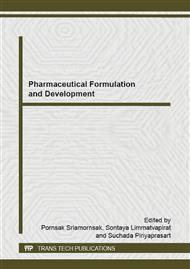p.119
p.124
p.128
p.133
p.137
p.141
p.145
p.151
p.155
Swelling Behaviour of Carboxymethylated Tamarind Gum
Abstract:
Chemical composition and swelling behaviour of crude tamarind gum from Tamarindus indica seed were observed and compared with modified gums as used carboxymethylation reaction. The condition of carboxymethylation at 70°C for 60 min of reaction time and methanol as solvent media was used. Different mole ratios of sodium hydroxide to monochloroacetic acid (nNaOH/nMCA) from 1 to 2.78 were studied and then its degree of substitution (DS) of both crude and carboxymethylated tamarind gums was also determined and compared. Then the swelling property of all samples was evaluated by using gravimetric technique (weight difference between dry and wet polymer). The results from swelling test showed that crude tamarind gum behaved low swelling while carboxymethylated tamarind gums showed high swelling profiles, ranged from 17 to 81% during 60 min. This is a preliminary assessment to expressing pharmaceutical application possibility of tamarind gum as disintegrant, diluent and drug release controlling agent.
Info:
Periodical:
Pages:
137-140
Citation:
Online since:
December 2014
Price:
Сopyright:
© 2015 Trans Tech Publications Ltd. All Rights Reserved
Share:
Citation:


